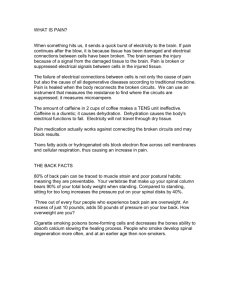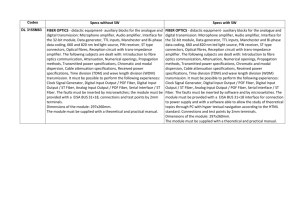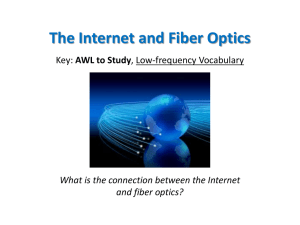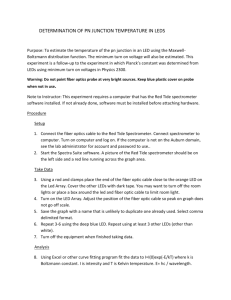Fiber optics
advertisement
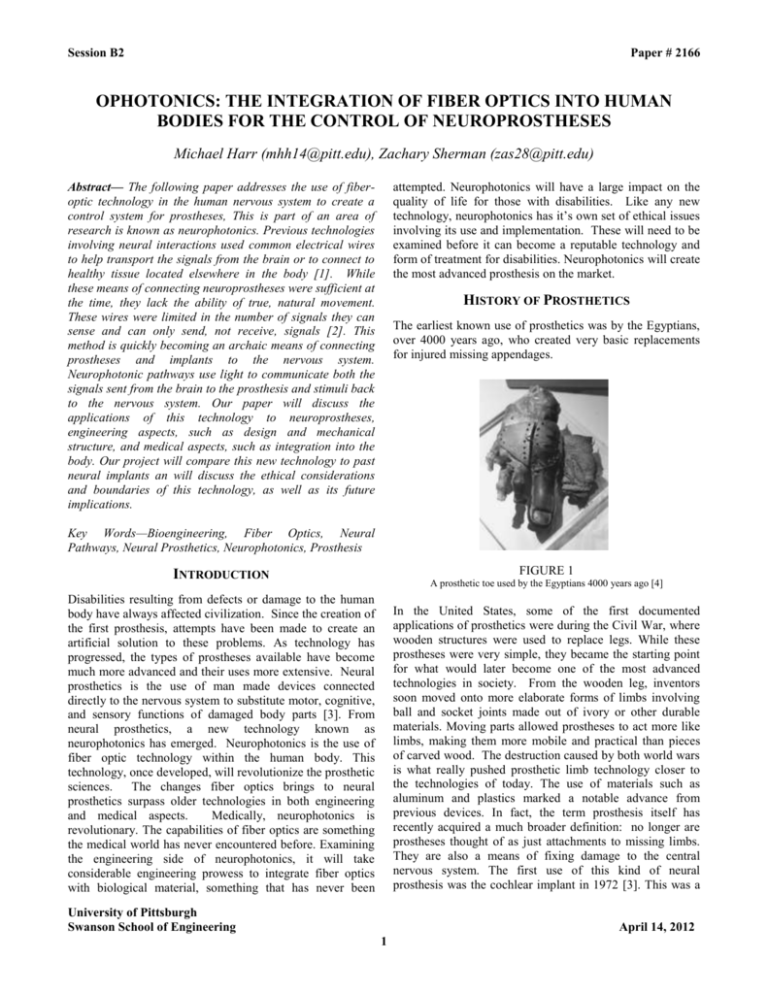
Session B2 Paper # 2166 OPHOTONICS: THE INTEGRATION OF FIBER OPTICS INTO HUMAN BODIES FOR THE CONTROL OF NEUROPROSTHESES Michael Harr (mhh14@pitt.edu), Zachary Sherman (zas28@pitt.edu) Abstract— The following paper addresses the use of fiberoptic technology in the human nervous system to create a control system for prostheses, This is part of an area of research is known as neurophotonics. Previous technologies involving neural interactions used common electrical wires to help transport the signals from the brain or to connect to healthy tissue located elsewhere in the body [1]. While these means of connecting neuroprostheses were sufficient at the time, they lack the ability of true, natural movement. These wires were limited in the number of signals they can sense and can only send, not receive, signals [2]. This method is quickly becoming an archaic means of connecting prostheses and implants to the nervous system. Neurophotonic pathways use light to communicate both the signals sent from the brain to the prosthesis and stimuli back to the nervous system. Our paper will discuss the applications of this technology to neuroprostheses, engineering aspects, such as design and mechanical structure, and medical aspects, such as integration into the body. Our project will compare this new technology to past neural implants an will discuss the ethical considerations and boundaries of this technology, as well as its future implications. attempted. Neurophotonics will have a large impact on the quality of life for those with disabilities. Like any new technology, neurophotonics has it’s own set of ethical issues involving its use and implementation. These will need to be examined before it can become a reputable technology and form of treatment for disabilities. Neurophotonics will create the most advanced prosthesis on the market. HISTORY OF PROSTHETICS The earliest known use of prosthetics was by the Egyptians, over 4000 years ago, who created very basic replacements for injured missing appendages. Key Words—Bioengineering, Fiber Optics, Neural Pathways, Neural Prosthetics, Neurophotonics, Prosthesis FIGURE 1 INTRODUCTION A prosthetic toe used by the Egyptians 4000 years ago [4] Disabilities resulting from defects or damage to the human body have always affected civilization. Since the creation of the first prosthesis, attempts have been made to create an artificial solution to these problems. As technology has progressed, the types of prostheses available have become much more advanced and their uses more extensive. Neural prosthetics is the use of man made devices connected directly to the nervous system to substitute motor, cognitive, and sensory functions of damaged body parts [3]. From neural prosthetics, a new technology known as neurophotonics has emerged. Neurophotonics is the use of fiber optic technology within the human body. This technology, once developed, will revolutionize the prosthetic sciences. The changes fiber optics brings to neural prosthetics surpass older technologies in both engineering and medical aspects. Medically, neurophotonics is revolutionary. The capabilities of fiber optics are something the medical world has never encountered before. Examining the engineering side of neurophotonics, it will take considerable engineering prowess to integrate fiber optics with biological material, something that has never been In the United States, some of the first documented applications of prosthetics were during the Civil War, where wooden structures were used to replace legs. While these prostheses were very simple, they became the starting point for what would later become one of the most advanced technologies in society. From the wooden leg, inventors soon moved onto more elaborate forms of limbs involving ball and socket joints made out of ivory or other durable materials. Moving parts allowed prostheses to act more like limbs, making them more mobile and practical than pieces of carved wood. The destruction caused by both world wars is what really pushed prosthetic limb technology closer to the technologies of today. The use of materials such as aluminum and plastics marked a notable advance from previous devices. In fact, the term prosthesis itself has recently acquired a much broader definition: no longer are prostheses thought of as just attachments to missing limbs. They are also a means of fixing damage to the central nervous system. The first use of this kind of neural prosthesis was the cochlear implant in 1972 [3]. This was a University of Pittsburgh Swanson School of Engineering April 14, 2012 1 Michael Harr Zachary Sherman very large step for prosthetics because it was the first device that worked in unison with the nervous system. The cochlear implant connects to nerves inside the ear, where it can send impulses straight to the brain via these nerves. Another common neuroprosthesis is the pacemaker, which is used to keep the heart on a healthy rhythm. Although the pacemaker is not replacing any human part, it is considered a prosthesis because of its ability to keep a patient’s heart functioning properly through artificial means. to move it to the correct location [6]. Another problem arises from the electrodes that are implanted in the body. They are made out of metal, which the body tends to reject and corrode over time. This makes the device only last for about six to twelve months [7]. The electrical wires used to send the signal from he electrodes to the prosthesis. While normally sufficient for controlling an electrical device, they lack the ability of bi-directional signaling and when compared to the speed the brain sends signals to the nervous system, they can be a fraction of a second off. These wires are also unable to sense the large variety of signals that the brain can send meaning fine motor control is hard to achieve. Despite being able to control these prostheses through thought, it often has to be deliberate and lacks the natural, reaction-like movement of a real limb. CURRENT TECHNOLOGIES Today, there are currently three different types of neuroprostheses in use: sensory prosthetics, motor prosthetics, and cognitive prosthetics. These have a variety of different functions. Sensory prosthetics repair damage to the senses such as sight or hearing, motor prosthetics replace a missing body part or help stimulate malfunctioning areas, and cognitive prosthetics, while still largely under development, replace sections of the brain itself [3]. With such a variety of prostheses available, there is also a variety of ways they can be controlled. FIBER OPTICS The general consensus with many is that fiber optic technology is just the wires that supply the Internet and cable TV to a household. While fiber optics is most commonly used for these types of data transportation, they have the potential to be used in multiple other capacities. The reason fiber optic technology is so versatile lies in how data and signals are transported through them. Comparable to the metal wires that are used in a majority of technologies, fiber optics is based on much deeper understandings of how light and energy can be transported. Only within the past few decades has fiber optic technology become a practical means of data transportation. The proper functioning of fiber optics relies heavily on ideas from optical physics [8]. Optical physics is the study of electromagnetic radiation and also how that radiation interacts with matter. The scientists and engineers behind fiber optic technology have constructed a means of controlling the content and direction of light through these fibers. There are currently two means of transporting light using fiber optics, single mode fiber and multimode fiber. With single mode, the light travels in a straight line through a hollow glass fiber. This fiber, which is 1/80 the width of a human hair, can transport light with little to no interference. This is the most effective way of transporting light, but it is also the most expensive due to the size of the materials. Multimode fibers rely on the bouncing of light through the hollow glass fiber. These fibers are only about 1/8 the width of human hair [8]. Because the fibers are small glass tubes, this allows light to travel both forward and backward through them. Either form of transportation can send ten times the amount of data that an electrical wire can [9]. They send the data at incredibly high speeds due to it being carried by light, which travels at 10,000 times faster than the highest radio frequency [8]. The speed and multi-directional ability with which data can be transferred are what make fiber optics such a revolutionary technology. Current Control Systems The most advanced control system currently on the market consists of electrodes either placed over the nerves from where the limb was lost or implanted directly in the brain. The former, called targeted muscle reinnervation, moves the nerves from the remaining part of the limb to another area of the body, often the chest. Electrodes are then placed on the skin above the new location of these nerves. When the brain thinks about moving the amputated limb, the nerves contract part of the muscle they were moved to. This impulse that cause a muscle contraction is called a myoelectric signal. The electrodes sense this signal and relay an equivalent electric signal to the artificial limb [5]. The other implementation of electrodes for the control of prostheses is to implant them directly into the part of the brain that controls the missing limb. This offers even more direct control than targeted muscle reinnervation and also bypasses the old nerves altogether, allowing for potential use by the paralyzed or those whose limb was too damaged for the nerves to be reused. When the patient thinks about moving their limb, the part of the brain responsible activates and stimulates the electrode, which then relays the signal to the prosthesis [6]. The obvious advantage to these techniques is that they allow a prosthesis to be moved by thought alone, something that was a major breakthrough when it was first available. These neuroprostheses are also readily available today, allowing almost any amputee to use them. There are negatives, however. For instance, the brain floats freely in the skull, while an implanted electrode remains where it was placed. This means even a minor collision can cause the electrode to become wrongly aligned. The patient would have to undergo a very invasive surgery 2 Michael Harr Zachary Sherman SMU, created a solution to the problem. He developed an entirely new type of spherical whispering gallery mode sensor [13]. They were given this name because they can pick up on even the smallest of signals, similar to how if you stand in a small-enclosed dome, you can hear whispers on the opposite side of the building. In order to understand how these sensors work, on has to first understand how nerve signals work. Nerve cells, or neurons are connected to one another in a long system. Each of the cells has antenna like structures, called dendrites, around the body of the cell and a single, long axon. The axon of one neuron connects to the dendrites of another with a small gap in between. At these gaps, called synapses, chemical transmitters jump from one neuron to the other. This is caused by a change in electrical charge across the cell membrane when a signal is sent from the brain. The chemicals are the forced to move and pass the signal on [14]. This change in electric charge is what is important for the sensors. WGM sensors detect miniscule changes in an electric field. This is perfect for detecting the myoelectric pulses sent through neurons. Light travels through the optical fiber, along the surface of the inside of the sphere, back into the fiber again. One round-trip gives off a resonance in the form of an integer multiple of the wavelength of the light being sent. This resonance is what is examined to determine what is happening in the sensor. When a signal is sent down the nerve that the sensor is located by, the electric field created distorts the spherical sensor. It can cause changes in size, shape, or refractive index. This disrupts the resonance pattern. The stronger the impulse, the more the resonance pattern gets disrupted. This disturbance is then read as an optical equivalent to the nerve impulse [7]. By relating the change in the optical signal to the signal sent through the nerves, the prosthetic limb then knows it should move. Based on the particular nerve and the strength of the impulse, the limb knows how to move and how quickly and precisely to do so. The specific WGM sensors Professor Otugen created are made of a soft material called polydimethylsiloxane. It has similar texture to silicone and feels like real tissue, but most importantly, it is completely biocompatible [7]. The spheres are only about fifty microns in diameter, allowing hundreds to be embedded on a single optical fiber. They also have the remarkable ability to stimulate the nerves they are implanted in. This allows for two-way communication and the potential for advanced future uses. Multiple systems are being considered to attach these sensors to the nerve, but the most viable system is a cuff. It would house a large number optical fibers and would be connected to the prosthesis at one end and the nerves at the other [15]. The fibers will then extend out of the cuff into the nerve where they will be able to sense any signals sent down the axons. Once these signals are sensed, they are relayed to the prosthetic limb. In the prosthesis, a computer programmed to interpret these signals as orders for FIGURE 2 The differing ways light can travel through an optical fiber [10] INTEGRATION OF FIBER OPTICS Using fiber optics in the human body is the definition of neurophotonics. A way to directly connect the optic fiber to the human nervous system had to be developed, along with a surgical procedure to implement it. This required the research team working on neurophotonics to have more forward thinking than what would normally be required; creating technology that has real potential for practical use. Origin Neurophotonics originated as a field in 2005 when researches at Vanderbilt discovered that a nerve could be stimulated using infrared light. In fact, a nerve can be stimulated this way without any form of touch or other stimulus at all. Using rats, a group of biomedical engineers was able to stimulate nerves in their hind legs and actually control the muscles in the leg and even individual toes. They had originally started the experiment not with nerve stimulation in mind, but attempting to use light to detect the movement of an electrical impulse from a nerve [11]. Their key discovery was just pure coincidence. This experiment gave way to the idea of using light to transmit messages to and from the brain. More recently, DARPA, the Research and Development branch of the Pentagon, funded Southern Methodist University with $5.6 million as a part of its Centers in Integrated Photonics Engineering Research, or CIPhER [12]. Headed by Marc P. Christensen, their goal is to further neurophotonic research and to develop a way to integrate fiber optics directly into the body. Engineering Aspects How to connect the optical fibers to the nervous system is the main challenge of neurophotonics. A way to seamlessly integrate sensors into the nerves without them being rejected needed to be developed. Volkan Otugen, a professor at 3 Michael Harr Zachary Sherman movement then instructs the limb in what to do. This all happens in the blink of an eye. piece of contrasting material is placed behind the nerve to make it more visible. Microscopic incisions are then made in the nerve. Once the incisions are made, the neurophotonic interface cuff is placed over the nerve allowing the fiber optic probes to be inserted into the nerve itself [17]. At this point in the procedure, the optical fibers have been successfully integrated into the nervous system and the patient can be sewn up and the surgery completed. Benefits Fiber optics has numerous benefits over the older technology. They are more efficient, more compatible with the body, and more powerful. All of this is why researchers are putting a lot of effort into neurophotonics. The capabilities provided are tremendous when compared to anything on the market today. Optical fibers, as previously mentioned, carry ten times the data of their electric counterparts. Combine this with the more direct connection provided by implanting the fibers directly in the nerve instead of an putting electrode in the brain or moving the nerves to another part of the body, and The overall process is vastly more efficient. Data travels faster from the brain to the prosthesis. No longer would patients have to cope with their movements being a fraction of a second slower than a real limb. Optical fibers actually have the potential to be faster than our real nervous system [18]. Removing the delay caused by previous prostheses makes the limbs more life-like. One of the major problems with previous neuroprostheses was their lack of biocompatibility. With fiber optics, the main materials are flexible glass, polymer fibers, and the polydimethylsiloxane of the sensors. All of these materials are compatible with living tissue, avoiding a response from the immune system, and pushing the lifespan of the device up to ten or more years [7]. They are all incredibly durable while maintaining a tissue-like quality. Finally, and maybe most importantly, neurophotonic prostheses are much more powerful than their electronic counterparts. What this power comes down to is the ability to control the prosthesis with the fine movement of a real limb. Especially evident in a hand, the patient would be able to do things never thought possible with an artificial limb [13]. The user would be able to do play the piano, rotate their wrist, or pick something up with delicacy and care. All the benefits created by neurophotonics sum up to a single overall betterment: an increase in the quality of the patient’s life. No better reason could exist to create a technology than to help someone. By returning a person’s abilities back to what they were before the loss of a limb, his or her life could regain the normalcy they want. They could participate in hobbies or other interests they may not have been able to do without the limb, and this would be a great achievement. FIGURE 2 A nerve with a neurophotonic cuff attached [15] Medical Aspects Human neurons range in width from 4 to 100 microns. This is smaller than a human hair. To work with something so small, a special type of surgery, called microsurgery, is used. As its name suggests, this type of surgery is performed under a microscope. A magnification of five to forty times is usually used. This magnifies the operating field enough that the surgeon can properly see structures almost invisible to the naked eye. Video is also taken of the surgical area so the rest of the medical team can view the operation [16]. The instruments that surgeons use for microsurgery have to be capable of finely manipulating such small structures. They have to have handles large enough that the surgeon can hold on to them properly, but the working end has to be small enough that it is not cumbersome when being used on the patient. The tremor of a surgeon’s hand also needs to be taken into account, because even a slight movement can have a drastic effect on such a small scale. These tools include forceps, needle holders, scissors, vascular clamps, irrigators, and other standard surgical tools, all much smaller than their normal counterparts [16]. In order to use the instruments and perform these procedures, a surgeon needs specific training. Special techniques need to be taught such as minimizing hand tremor and proper posture [16]. Proficiency at microsurgical techniques is important, especially considering how important these body parts normally are. If a surgeon makes a mistake implementing a neurophotonic device, for instance, damage could occur to the nerves, causing the patient to lose more feeling than they already have. When the optical fibers are ready to be implanted into the nerve, a series of steps needs to be followed first. The ends of the peripheral nerves need to be trimmed to expose healthy nerve tissue. If the were no nerves left after the loss of a limb, healthy nerves need to be grafting from another part of the body to be used in the device. From this point, a 4 Michael Harr Zachary Sherman advances, the impact neurophotonics will have on the future of medicine will be astonishing. THE ETHICS OF NEUROPHOTONICS The ethics of a technology are one of the most important considerations for an engineer, especially bioengineers whose technologies directly impact the quality of human life. The medical field has its own code of ethics that differ from the biomedical engineering code of ethics as well. When creating a new technology, both codes need to be considered. If the technology does not fall under the guidelines of one, then it cannot ethically be developed. The Biomedical Engineering Society has created a code of ethics for bioengineers to follow that includes considerations of cost, availability, and respecting the rights of the patients [19]. For any engineer, cost can be an ally or an enemy. If a technology is too expensive, it cannot reasonably be manufactured, whereas if it’s cheap, it has a benefit over older, more costly technologies. This is just another area where fiber optic technology shines. A fiber optic cable is actually cheaper than a typical copper electrical wire. Alongside cost is availability. If the materials to create a device are not easily attainable, it will drive the cost way up. With fiber optics already well known and used in other parts of society, the necessary materials are not hard to come by. Considerations about a patient’s rights and privacy are pulled directly from the American Medical Association’s medical code of ethics, but this is where the similarities end. The medical code specifically states that the quality of care is more important than cost, meaning an expensive but helpful technology will be pushed into use [20]. In fact, engineers and physicians often have conflicting views about when a prosthesis is ready for human testing. Physicians think the prosthesis should be put into testing as soon as possible whereas engineers favor waiting until all possible non-human testing is done [21]. Other medical considerations involve the surgical procedures for implementing the fiber optics. The procedures should be as minimally invasive as possible. Any type of surgery has risk involved. This risks need to be weighed against the benefits of the procedure to decide if it is worth the trouble for a patient. Luckily, microsurgery is a very noninvasive and low risk process. However, this riskto-benefit comparison still needs to be examined on a caseby-case basis for each patient. Every patient has specific health related issues, which may determine if the prosthesis is right for him or her. The Science of Feeling The multi-directional capacity of fiber optics will help to make it even more valuable in the coming years. This simple quality of optical fibers will allow seamless communication between the prosthetic limbs and peripheral nerves. The speed by which data will be transported by fiber optics also makes it the optimum technology for this application. By connecting the peripheral nerves to the prostheses via a fiber optic cable, realistic robotic arms, legs and hands can be created that move like the real thing [12]. The expected process for how this technology facilitates feeling in a limb occurs as follows; let’s consider that a user of this new prosthesis wants to pick up a cup of hot coffee. First, signals are sent from the brain via existing nerves until they reach the neurophotonic connection. The signals will travel from the neurons into the fiber optic cables and then into the prosthetic arm. Processors inside the arm will analyze these signals and consequently move the arm towards the cup of coffee. As the prosthetic hand grasps the cup of coffee, a variety of sensors on the hand will detect feelings such as pressure and warmth from the cup. These signals will then be processed and sent back up the arm. The signals are next sent into the fiber optic cables and directed to the corresponding peripheral nerves that are used for those sensations. The signals will then travel back to the brain and the user will ‘feel’ the pressure and warmth when they are holding the cup. This is one of the hopeful byproducts of combining neurophotonic technology with neuroprostheses. While this is a great achievement in the medical and engineering world, those researching this technology hope to go even further. Application to Spinal Cord Injuries Researchers in the neurophotonic field anticipate the applications of this technology to go far beyond just prostheses and enter into the world of spinal chord damage. The eventual integration of this technology will hopefully bring an end to all the side effects cause from spinal chord injury. Spinal chord injuries have the potential to completely alter the quality of life of an individual who has one. Depending on the severity, spinal chord injuries can be as minor as a loss of feeling in a finger to as serious as loss of movement from the neck down. Injuries occur when trauma to the spine causes damage to the spinal chord. In some cases, if the damage is severe enough, it can cause severing of the spinal chord and complete loss of motor control. Those researching neurophotonics believe that this technology can provide a solution to this type of injury. By creating a bridge over the severed section of spine, the nerves can be connected to one another the same way as how they are connected to a prosthetic [13]. NEUROPHOTONICS AND THE FUTURE Faster signal processing and a higher compatibility with the human body are just the beginning of where engineers hope to go with neurophotonics in the body. While these improvements will revolutionize the use of prosthetics, neurophotonics will also continue to improve and become more applicable to other injuries involving the human body. While high tech prostheses will continue to make important 5 Michael Harr Zachary Sherman NEUROPHOTONICS: LIGHT UP YOUR BODY REFERENCES Neurophotonics is on the forefront of the engineering world and is going to become one of the most advanced technologies our society has ever seen. From the start of the first prosthesis in ancient Egypt to the invention of fiber optics, these advances have since improved and merged to facilitate the use of neurophotonics to control neuroprostheses. Since Vanderbilt researchers discovered the potential use of light in the body in 2005, even more innovations have been made. SMU continues to research neurophotonics today. They have created a sensor capable of picking up on even the smallest of neural impulses using only light. These sensors not only read neural impulses, but can stimulate the nerve as well, allowing for bi-directional communication. Integrated into the nervous system through the use of cuffs housing the optical fibers, all the materials used will be completely biocompatible. Medically, microsurgery allows for the neurophotonic devices to be integrated into the body. Microscopes and special instruments are used to allow for surgery on such a small part of the body. Specially trained surgeons are then capable of implanting the optical fibers directly into the nerves. A multitude of benefits arise out of fiber optics in the body. A higher efficiency and biocompatibility are chief among them, but the most important improvement is the power of control in the prostheses. No longer will a user be unable to do the things someone without an amputation can. These benefits come together to greatly improve the lives of the users of neurophotonic prostheses. With ethics being an important part of any new technology, multiple codes of ethics need to be taken into account. Both the BMES code and the AMA health code need to be considered. Neurophotonics has proven thus far to be a very ethical technology. Lowering cost, raising availability, and improving the lives of the people using the prostheses all make it a viable technology. As this technology begins to be implemented in actual clinical trials, it will undoubtedly increase the quality of life for those needing prostheses. The ability to create a more mobile and realistic prosthetic limb is something that was always strived for when producing new prosthetics. The future plans for this technology are equally as impressive. The ability to allow a user to experience sensations such as warmth and pressure are very futuristic compared to what exists today. Not only will this technology benefit the prosthetic community, but also the future implications it could have on injuries involving the spinal chord would be even more revolutionary. The possibility to ‘revive’ damaged parts of the spinal chord could allow neurophotonics to be the genesis of a brand new way of treating these types of injuries. As research continues into the future, we will surely see the creation of innovative and astounding technologies. [1] C. Dillow. (2010, Sept. 23). “DARPA Funds Neurophotonics Center to Develop Fiber-Optic Link Between Brain and Prosthetics.” Popular Science. [Online.] Available: http://www.popsci.com/science/article/201009/darpa-funds-neurophotonics-center-develop-fiber-optic-interfacenervous-system [2] M. Bryner. (2010, Sept. 23). “Fiber Optics Could ‘Humanize’ Future Prosthetic Limbs.” TechNewsDaily. [Online]. Available: http://www.technewsdaily.com/1202-fiber-optics-could-humanize-futureprosthetic-limbs.html [3] A. Kumari and R. Kumari. “Neuroprosthetics.” Cyberworld. [Online]. Available: http://www.asctbhopal.com/visiontechsouvenir2009/cyberworld/neuroprost hetics.pdf [4] A. Thurston (2007, Oct. 27). “Pare and Prosthetics: The Early History of Artificial Limbs” ANZ Journal of Surgery. [Online]. Available: http://onlinelibrary.wiley.com/doi/10.1111/j.1445-2197.2007.04330.x/full [5] P. Belluck. (2009, Feb. 10) “In New Procedure, Artificial Arm Listens to Brain.” The New York Times. [Online Article]. Available: http://www.nytimes.com/2009/02/11/health/research/11arm.html [6] A. Kumari and R. Kumari. “Neuroprosthetics.” Cyberworld. [Online]. Available: http://www.asctbhopal.com/visiontechsouvenir2009/cyberworld/neuroprost hetics.pdf [7] M. Peck. (2011, Oct. 21). “The “Skywalker Hand: Researchers Using Light to Create Prosthetics That Feel.” Txchnoligist. [Online]. Available: http://www.txchnologist.com/2011/the-skywalker-hand-researchers-usinglight-to-create-prosthetics-that-can-feel [8] (2008, Dec. 5). “Fiber-Optics.” Fiber-Optics.info. [Online]. Available: http://www.fiber-optics.info/history/P1/ [9] M. Peck. (2011, Feb. 24). “Talk to the Hand: A New Interface for Bionic Limbs.” PopSci. [Online]. Available: http://www.popsci.com/technology/article/2011-02/talk-hand-newinterface-bionic-limbs [10] T. Sheldon. (2011). “Fiber-Optic Cable.” Linktionary. [Online]. Available: http://www.linktionary.com/f/fiber-optic.html [11] V. Cooper-Capps. (2005, March 10). “A Major Step Toward Controlling Artificial Limbs Directly From the Brain.” Exploration. [Online]. Available: http://www.vanderbilt.edu/exploration/text/index.php?action=view_section &id=354&story_id=96&images [12] (2011, Jan.). “Neurophotonic Sensors for Bionic Limbs.” SPIE. [Online]. Available: http://spie.org/x43731.xml [13] M. Allen. (2010, Sept. 8). “SMU Leads $6.5M Research Center for Fiber Optic Interface to Link Robotic Limbs, Human Brain.” SMUResearch. [Online]. Available: http://blog.smu.edu/research/2010/09/08/smu-leads-5-6m-research-centerfor-fiber-optic-interface-to-link-robotic-limbs-human-brain/ [14] (2012). “Nervous System Guide.” National Science Teachers Association. [Online]. Available: http://www.nsta.org/publications/interactive/nerves/basics/how_nerves_wor k.html [15] K. Drummond. (2011, Nov. 3). “Lasers Power Pentagon’s Next-Gen Limbs.” Wired. [Online Article]. Available: http://www.wired.com/dangerroom/2011/11/fiber-optic-prosthetics [16] S. Sherk. (2003). “Microsurgery.” Surgery Encylopedia. [Online]. Available: http://www.surgeryencyclopedia.com/LaPa/Microsurgery.html#b [17] (2011, Jan. 7). “SMU Neurophotonics.” Neurophotonics Research Center. [Online]. Available: http://www.scribd.com/doc/67904658/SMUNeurophotonics [18] J. Serrao. (2010 Sept. 20) “Neurophotonics Coming to a Human Being Near You” Nutrition Wonderland. [Online]. Available: http://nutritionwonderland.com/2010/09/neurophotonicshuman-being/ [19] (2011) “Biomedical Engineering Society Code of Ethics.” Biomedical Engineering Society. [Online Web site]. Available: http://www.bmes.org/aws/BMES/pt/sp/ethics [20] (2012) “AMA’s Medical Code of Ethics.” American Medical Association. [Online]. Available: http://www.ama- 6 Michael Harr Zachary Sherman assn.org/ama/pub/physician-resources/medical-ethics/code-medicalethics.page [21] V. Chase. (2007 Feb. 13). “The Ethics of Neural Prosthetic.” Bioethics Forum. [Online]. Available: http://www.thehastingscenter.org/Bioethicsforum/Post.aspx?id=346&blogid =140 ADDITIONAL SOURCES (2010). “Brain Cells.” Enchanted Learning. [Online]. Available: http://www.enchantedlearning.com/subjects/anatomy/brain/Neuron.shtml B. Dickinson. (2010, Sept. 24). “Artificial Limbs That Feel: How a fiber Optic Connection Will Hook Up Prosthetics to the Brain.” Smart Planet. [Online Article]. Available: http://www.smartplanet.com/blog/sciencescope/artificial-limbs-that-feel-how-a-fiber-optic-connection-will-hook-upprosthetics-to-the-brain/4342 (2010, Nov. 30). “Doctors Using Fiber Optics for Prosthetic Limbs.” CBSDFW. [Online Article]. Available: http://dfw.cbslocal.com/2010/11/30/doctors-using-firber-optics-forprostetic-limbs/ J. Fritz. (2011, Nov. 4). “Fiber Optics is Bringing Life-Like Motor Control to Prosthetics.” Wallstreet Daily. [Online Article]. Available: http://www.wallstreetdaily.com/2011/11/04/fiber-optics-is-bringing-lifelike-motor-control-to-prosthetics/ G. Handa. (2006, April 17). “Neural Prosthesis - Past, Present, and Future.” Indian Journal of Physical Medicine and Rehabilitation. [Online.] Available: http://www.ijpmr.com/ijpmr0601/editorial0601.pdf J. D. Houle. (2009). “Combining Peripheral Nerve Grafting and Matrix Modulation to Repair the Injured Rat Spinal Cord.” J. Vis. Exp. [Online Article]. Available: http://www.jove.com/video/1324/combining-peripheralnerve-grafting-and-matrix-modulation-to-repair-the-injured-rat-spinal-cord (2003, Nov.). “Myoelectric Signal (Motor Action Potential).” SearchMobileComputing. [Online]. Available: http://searchmobilecomputing.techtarget.com/definition/myoelectric-signal ACKNOWLEDGMENTS We would like to thank our writing instructor, Barbara Edelman, for the help she has given us on writing our paper as well as our fellow students for helping to create a proper atmosphere for doing work. 7


